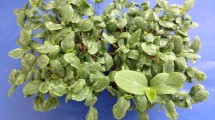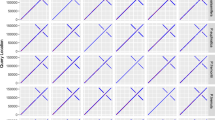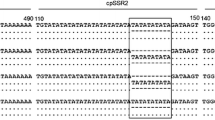Abstract
A simple procedure for the amplification of chloroplast DNA from pollen is described. This allows the potential for biparental or paternal inheritance of chloroplasts in angiosperms to be established rapidly and reliably. Such information is important when chloroplast DNA, which is generally assumed to be inherited maternally, is used to study gene flow or reconstruct phylogenies. The technique could also prove valuable in assessing the risks of transgene escape via pollen of genetically modified plants, in which the chloroplast genome rather than the nucleus has been transformed.
Similar content being viewed by others
Abbreviations
- ctDNA:
-
chloroplast DNA
References
Amoatey HM and Tilney-Basset RAE (1994) A test of the complementary gene model for the control of biparental plastid inheritance in zonal Pelargoniums. Heredity 72: 69–77.
Birky CW (1995) Uniparental inheritance of mitochondrial and chloroplast genes: mechanisms and evolution. Proc Nat Acad Sci USA 92: 11331–11338.
Corriveau JL and Coleman AW (1988) Rapid screening methods to detect potential biparental inheritance of plastid DNA and results for over 200 angiosperm species. Am J Bot 75: 1443–1458.
Hagemann R (1992) Cell organelles: Plastid genetics in higher plants. Plant Gene Research, New York, Springer-Verlag. 66–96.
John DM, Bhoday R, Russell SJ, Johnson LR and Gacesa P (1993) A molecular and morphological analysis of Microthamnion (Chlorophyta, Microthamniales). Archiv fuer Protistenkunde 143: 33–99.
Maliga P (1993) Towards plastid transformation in flowering plants. TIB Techniques 11: 101–107.
Metzlaff M, Borner T and Hagemann R (1981) Variations of chloroplast DNAs in the genusPelargonium and their biparental inheritance. Theor Appl Genet 60: 37–41.
Nagata N, Saito C, Sakai A, Kuroiwa H and Kuroiwa T (1999) The selective increase or decrease of organellar DNA in generative cells just after pollen mitosis one controls cytoplasmic inheritance. Planta 209: 53–65.
Sodmergan T, Suzuki T, Kawano S, Nakamura S, Tano S and Kuroiwa T (1992) Behavior of organelle nuclei (nucleoids) in generative and vegetative cells during maturation of pollen inLilium longiflorum andPelargonium zonale. Protoplasma 168: 73–82.
Taberlet P, Gielly L, Patou G and Bouvet J (1992). Universal primers for amplification of three non-coding regions of chloroplast DNA. Plant Mol Biol 17: 1105–1109.
Tilney-Basset RAE (1973) The control of plastid inheritance inPelargonium II. Heredity 1: 1–13.
Author information
Authors and Affiliations
Corresponding author
Rights and permissions
About this article
Cite this article
James, C.M., Barrett, J.A., Russell, S.J. et al. A rapid PCR based method to establish the potential for paternal inheritance of chloroplasts inPelargonium . Plant Mol Biol Rep 19, 163–167 (2001). https://doi.org/10.1007/BF02772159
Published:
Issue Date:
DOI: https://doi.org/10.1007/BF02772159




